In 1910 Konchalovsky goes to France again, communicates much with Vasily I.Surikov and studies the “skill of painter’s vision” at him.
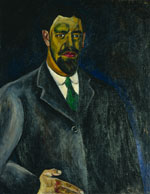
Self-Portrait. 1910
The passion for the French impressionism proceeds.
From Paris he goes with V.I.Surikov to Spain (Madrid, Toledo, Grenada, Seville, Valencia and Barcelona). There he gets acquainted with the art of Velaskes.
From Spain – comes back to Arles, then with a family he rents a villa in Caldetas where on numerous rough drafts and sketches made in Spain, writes a picture «The Bullfight». The artist is interested by national Spanish art, and in work «The Bullfight» he makes the bull very primitive, similar to a national toy, aspiring to show an image most typical.
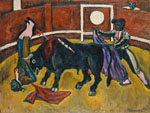
Bullfight. 1910
“Initially I have written «The Bullfight» absolutely realistic, Surikov considered this thing remarkable by vitality of its expression, but I did not like it. I desired to make the bull more typical, not just an animal, as everyone can see it, but similar to a toy in its primitiveness. I always loved folk art – those toy-makers of Troitsk which cut out of wood the bears with the muzhiks all theirs life. With fair simplicity and force they transfer the essence of an animal and the person, using the most elementary means, reducing all to the two-three most characteristic details. I desired to give the fighting bull the same “toy”, “muzhik” simplicity. I wanted it to seem like an awful toy, or even more – a “devil” as it was represented in Middle Ages in churches. So I have rewritten it. I remember, Surikov had considered, that I was mistaken and regretted the former bull, but I liked this new one, more “.
Quot. -V.A.Nikolsky – …the same, 1936 – p.46-47
The Spanish painting changes P.P. Konchalovsky’s palette. Color becomes wormer, shades – gloomy. The artist aspires to reach the Spanish – “simplified synthetic color “.
At that period he writes pictures: “The House”, “The Amateur of Bullfight”, “The Spanish Room” and “Matador Manuel Garta”.
The same year young artist comes back to Moscow and becomes one of the founders of an art society “The Jack of Diamonds”.
The quality of painting is proclaimed as its main advantage. Artists of the society realize the necessity “to work under the rules of new and quite certain method “.
One of the central works written by Konchalovsky after returning from Spain becomes “The Portrait of artist George Bogdanovich Jakulov”.
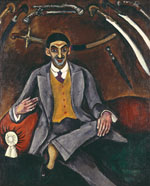
Portrait of the artist G.Jakulov. 1910
The artist characterizes it so: “I wrote Yakulov’s portrait being in a kind of victorious mood, I felt myself to be so strong in painting after Spain. In this portrait, in the most open, barefaced form, I wished to oppose prettiness and smoothness, beloved by many artists, with what is considered ugly in the general opinion, but actually is extremely beautiful. I wished to show the beauty and picturesque power of this imaginary “ugliness”, to show the essence of Yakulov’s character. Benua had learned somehow about this portrait, arrived to my studio and had persuaded to show a portrait at the nearest exhibition of “The World of Art” before it will be exposed in “The Jack of Diamonds”.
Konchalovsky – 796-4 p. 23
The artist spends 1911 in Moscow, leaving to Abramtzevo in the summer, where he writes a series of landscapes, still in the Spanish colors. Then he starts to be interested in Russian folk art and street signboards, and enters them into the city landscapes.
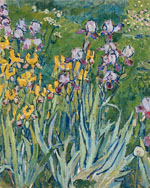
Irises. 1911

Tea-room in Khotkovo. 1911
“The roots of interest to the folk art and signboard of Konchalovsky, as well as of some other artists of an epoch, are in the aspiration which had captured them to express in painting only the most characteristic, and that, using the simplest means. Peculiar to a folk art and to the primitivism as a whole, generalization of forms and extreme miserliness of art language was, in essence, an acknowledgement of Cezanne’s doctrines about synthesis of the form, which made just at that time the triumphal procession in painting of many countries and peoples “.
Nikolsky – …1936 – p.51
Konchalovsky writes his first group portrait of his wife and children (“The Family portrait”, 1911). This picture continues the Spanish series of works of the master.
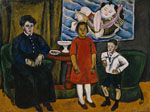
Family Portrait. 1911
Two colors are dominating there in Spanish manner: black and white. The red and green – though strongly given in a portrait – are playing strictly subordinated role and their aim is only to emphasize sonority of two basic tunes of a portrait. The Chinese picture entered into a background serves as accompaniment to these basic tones. It repeats again the black, grey and reflected tones of red (pink gills of a fish) and green (a bluish-green wave). At closer examination of this portrait, there would be already found some first sensations of materiality of subjects, and beginning of “constructivism”. Nikolsky – …1936 – p.53
Together with interest of the artist to the Spanish painting, his interest to creativity of Cezanne continues. In1912, E. Bernard’s book “Cezanne, his unpublished letters and memoirs about him” in P.P. Konchalovsky’s translation is published.
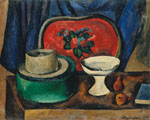
Still Life. Salver and green bandbox. 1912
In March Konchalovsky’s family accompanies V.I.Surikov to Berlin, then moves to Italy (Siena, Pisa, Assisi, Perugia).
In Siena the artist studies frescos of Signoreli, Simone Martin, Benozzio, Gozzoli, Piero Polaiollo. He makes study of the structure of composition, and flatness of forms of old masters.
“The family portrait” is one of significant works of that period.
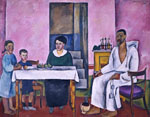
Family Portrait. 1912
The portrait is characterized by a spatial structure of composition aspiring to “fresco” style.
“I have noticed in Siena that people sometimes are taking sit in the Italian room for some reason as if they pose for a fresco. The life itself has suggested to me this circular, fresco construction for the portrait made in Siena. The circularity of composition, its spatiality is precisely emphasized here by a door with a ladder behind my wife, in the highest point of the semicircle. That monumentality of composition of the portrait is also given by Siena. In the color decision I kept to the primitive simplified tones. All is immensely simplified in frescoes as well, though the images represented in them quite often seems absolutely alive. I remember how I was pleased by a small “discovery” made in the portrait in Siena: ones, I have casually put a chair in front of the canvas which stood on the floor, at a wall, and it has appeared, that a chair simply “grown” into the picture, merged with it, despite the simplified nature of forms of the picture. I have tried to put other things in front of the portrait – the same effect, and they merged with canvas. So the secret of the “real” painting, by its qualities opposite to the naturalistic illusiveness, had been opened for me. This “secret” gave me the new strength and new courage, showing me new qualities of the painting which were far from impressionism.”
Nikolsky – …1936 – p. 56-57.
He also writes a series of town landscapes and still-lives in Siena and its vicinities closely studying a structure of natural forms.
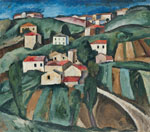
Near Siena. 1912
In the artist’s works of Siena it is possible to track the obvious influence of Cezanne and painting of cubists.
Returning to Moscow, the artist writes a number of still-lives, after the cubists entering into a composition the paper labels. By the master’s opinion, being entered into the picture, paper label forces the artist to raise the quality of painting, leading him up to the achievement of reality – “the tangible transfer of essence of subjects, not running to the measures of naturalistic extremity “.
Nikolsky – … 1936 – p.57.
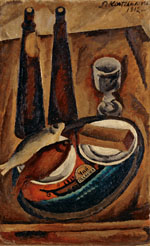
Still Life. Beer and a Roach. 1912
Simultaneously with aspiration to transfer the “essence” of a subject and attempts of decomposition of colors on a flat surface, Konchalovsky studies a constructive method of painting of subjects – cubism.
The works written in this manner are: self-portraits of 1912 and “Model”.
The method of cubism helps the artist to learn to take the most typical from the nature, teaches constructing a composition.
“It was necessary”, – the artist explains, – “to help me to seize the art of taking from the nature the most characteristic, essential, to learn constructing a composition, finally to be quit with traditions of naturalism in painting which restricted me around and with which the enormous part of Russian painting still lived and breathed … “.
Nikolsky – …1936 – p. 58.
In 1912 Konchalovsky carries out sketches of scenery and the suits to A.G.Rubinshtein’s opera «The Merchant Kalashnikov» for S.I. Zimin’s Opera Theatre. Scenery were not kept (had been lost at a fire). Earlier he has created sketches of a curtain for «Hamlet, Piero and the magician» for the Theatre of Miniatures of M.A. Artsybusheva.
In 1913 he makes a trip to the south of France, to the town of Cassis, near Marseilles where creates about ten pictures: views of port, sea coasts, rocks and mountains.
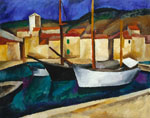
Cassis. Ships. 1913
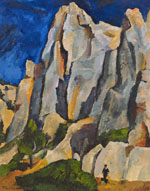
Cassis. Rocks. 1913
-Still continues to work using methods of cubism.
In the summer of 1914 he goes with family to Krasnoyarsk. On a way, in Urals Mountains, they are struck by the news about the beginning of war, and Konchalovsky is mobilized as the officer-gunner.
At war he writes some water colors as instructions to comrades on service, and during two months of stay in Moscow in 1915 paints the portrait “Natasha in an armchair”.
During arrival to Moscow in following year he writes a picture “Violin”.
The work is written in atypical for the artist careful, dry manner and can be considered as a signal of approaching of the new period. As well in the still-lives written in 1916 the turn to realism is observable. In “Agave” – the attention of the artist to the surface of a canvas, to “being processed” of its painting, to quality of the consistence of material is obvious.
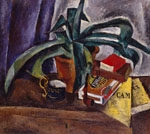
Agave. 1916
“I definitely would like then to process carefully the surface of a canvas. The value of the texture in painting was, certainly, clear to me ever before. I always admired, for example, Renoir’s texture, and the texture of Titian even was specially studied, but the problems of the kind were not arisen yet because there were other, more essential problems. The care of the texture can arise for an artist only when its painting manner has ripened already, and as to me, it had occurred only in 1916. I especially carefully prepared the canvas for “Agave”, and aspired in painting, that the texture of the surface would transfer external properties of subjects: chalky whiteness of a paper leaf, leaves of an agave poured by juice up to resilience, oiliness of the polished wood. The technique of the painting here also was extraordinary to me: I wrote on semidry, ran to the lessenings, used a lot of varnish. But after “Agave” I almost could not get off of the questions of texture, whatever I wrote. The care of a surface became one of components of my manner “. Nikolsky – … – p.63-64.